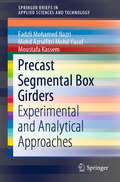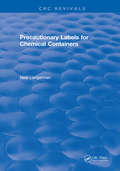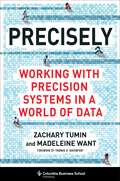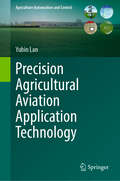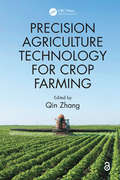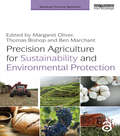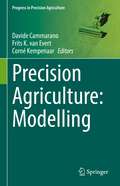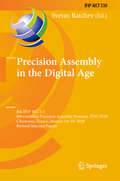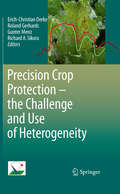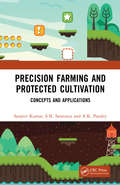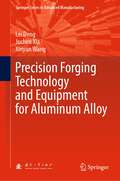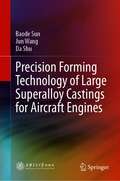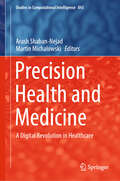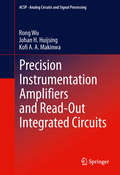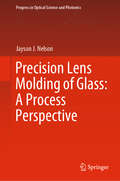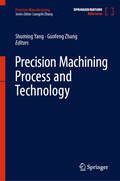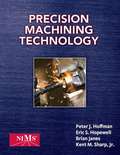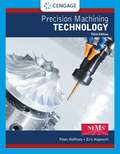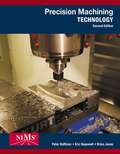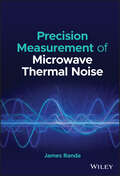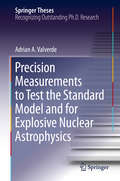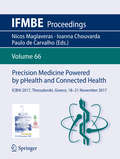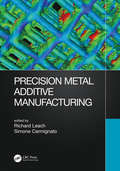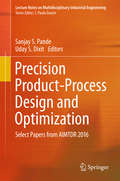- Table View
- List View
Precast Segmental Box Girders: Experimental and Analytical Approaches (SpringerBriefs in Applied Sciences and Technology)
by Fadzli Mohamed Nazri Mohd Azrulfitri Mohd Yusof Moustafa KassemThis book explores the fundamentals of the elastic behaviour of erected precast segmental box girders (SBG) when subjected to static load, as well as the construction process (casting and erection work) involved. It analyzes and compares the experimental results with those obtained using the finite element method and theoretical calculations. A short-term deflection analysis for different loads is obtained by determining the maximum deflection, stress and strain value of single span precast SBG under a variety of transversal slope. The outcome of this work provides a better understanding of the behaviour of precast SBG in terms of structural responses as well as defects, so that maintenance work can then be focused on the critical section at mid span area specifically for the bridge project longitudinally and transversely. The book is of interest to industry professionals involved in conducting static load tests on bridges, and all researchers, designers, and engineers seeking to validate experimental work with numerical and analytical approaches.
Precautionary Labels for Chemical Containers
by N. LangermanThis book focuses on chemical labels-the regulations behind them, the content and format, and how they are used. It looks at labels with relation to worker protection, because the chemical label is the single most important protective item workers will encounter in their day-to-day handling of chemicals. The book addresses chemical labels for non-bulk containers such as totes, drums, bottles, and boxes. The U.S. and Canadian regulations related to chemical containers present a framework for understanding the content of labels. This framework is then used to review protection against Failure-to-Warn litigation. Easily understandable methods are presented for teaching workers to use labels using proven procedures for minimizing the possibility of "putting the wrong stuff in the wrong pot." A complete description of the new American National Standards Institute MSDS format is provided. Reproductions of actual labels illustrate ideas, and detailed information is tabulated for ease of understanding.
Precisely: Working with Precision Systems in a World of Data
by Zachary Tumin Madeleine WantIf you want to win an election, improve the health of a city, or thrill your customers, you’re going to need precision systems—the highly engineered working arrangements of teams, processes, and technologies that put data and AI to work creating the change that leaders want, exactly how they want it. Big Tech firms like Amazon, Google, Apple, and Facebook have mastered their own precision systems, building trillion-dollar businesses using data-driven tools from mass-market “nudges” to industrial-grade recommendation systems.Precisely is the playbook for the rest of us. Zachary Tumin and Madeleine Want show how leaders in every domain are taking real-time precision systems into the marketplace, the political race, and the fight for health—from New York-Presbyterian Hospital to the New York Times, the NFL’s Baltimore Ravens to BNSF Railroad, the Biden-Harris campaign to the NYPD—to reveal elusive patterns, perform a repetitive task, run a play, or tailor a message, one at a time or by the millions.Precisely provides insight that will help leaders choose the system that’s right for them, decide which problem to tackle first, sell the importance of precision to stakeholders, power-up the people and the technology, and accomplish change that delivers precisely what’s needed every time—and do it all responsibly.
Precision Agricultural Aviation Application Technology (Agriculture Automation and Control)
by Yubin LanModern technologies and information tools can be used to maximize agricultural aviation productivity, allowing for precision application of agrochemical products. This book reviews and summarizes state-of-the-art precision agricultural aviation technologies that include remote sensing, aerial spraying and ground verification technologies. Furthermore, the author discusses the future of precision agricultural aviation technology with emphasis on key development directions in real-time image processing, variable-rate spraying, multi-sensor data fusion and RTK differential positioning, and other supporting technologies for UAV-based aerial spraying. This book serves as a reference for industry professionals by summarizing the history and achievements of UAV-based technologies, and encourages further development of precision agricultural aviation technologies. It is the 8th title of the "Agriculture Automation and Control" book series published by Springer.
Precision Agriculture Technology for Crop Farming
by Qin ZhangThis book provides a review of precision agriculture technology development, followed by a presentation of the state-of-the-art and future requirements of precision agriculture technology. It presents different styles of precision agriculture technologies suitable for large scale mechanized farming; highly automated community-based mechanized production; and fully mechanized farming practices commonly seen in emerging economic regions. The book emphasizes the introduction of core technical features of sensing, data processing and interpretation technologies, crop modeling and production control theory, intelligent machinery and field robots for precision agriculture production.
Precision Agriculture for Sustainability and Environmental Protection (Earthscan Food and Agriculture)
by Margaret A. Oliver Thomas F. A. Bishop Ben P. MarchantPrecision agriculture (PA) involves the application of technologies and agronomic principles to manage spatial and temporal variation associated with all aspects of agricultural production in order to improve crop performance and environmental quality. The focus of this book is to introduce a non-specialist audience to the the role of PA in food security, environmental protection, and sustainable use of natural resources, as well as its economic benefits. The technologies covered include yield monitors and remote sensing, and the key agronomic principles addressed are the optimal delivery of fertilizers, water and pesticides to crops only when and where these are required. As a result, it is shown that both food production and resource efficiency can be maximized, without waste or damage to the environment, such as can occur from excessive fertilizer or pesticide applications. The authors of necessity describe some technicalities about PA, but the overall aim is to introduce readers who are unfamiliar with PA to this very broad subject and to demonstrate the potential impact of PA on the environment and economy. Chapter 3 of this book is freely available as a downloadable Open Access PDF under a Creative Commons Attribution-Non Commercial-No Derivatives 3.0 license. https://s3-us-west-2.amazonaws.com/tandfbis/rt-files/docs/Open+Access+Chapters/9780415504409_oaChapter_3.pdf
Precision Agriculture: Modelling (Progress in Precision Agriculture)
by Davide Cammarano Frits K. van Evert Corné KempenaarThis book describes how models are used to monitor crops and soils in precision agriculture, and how they are used to support farmers’ decisions. The introductory section starts with an overview of precision agriculture from the early days of yield monitoring in the 1980s to the present, with a focus on the role of models. The section continues with descriptions of the different kinds of models and the opportunities for their application in precision agriculture. The section concludes with a chapter on socio-economic drivers and obstacles to the adoption of precision agriculture technologies. The middle section of the book explores the state-of-the-art in modeling for precision agriculture. Individual chapters focus on the major processes in precision agriculture: water use, nitrogen and other amendments, as well as weeds, pests and diseases. The final section contains a series of short chapters that each describe a commercial, model-based service that is currently available to farmers. The book aims to provide useful information to graduate-level professionals that want to broaden their knowledge of precision agriculture; to scientists who want to learn about using academic knowledge in practical farming; and to farmers, farm consultants and extension workers who want to increase their understanding of the science behind some of the commercial software available to the farming community.
Precision Assembly in the Digital Age
by Svetan RatchevThis book constitutes the refereed post-conference proceedings of the 8th IFIP WG 5.5 International Precision Assembly Seminar, IPAS 2018, held in Chamonix, France, in January 2018. The 20 revised full papers were carefully reviewed and selected from numerous submissions. The papers address topics such as machine vision and metrology for assembly operations, gripping and handling technologies, numerical methods and planning in assembly, digital technologies and Industry 4.0 applications, precision assembly methods, assembly systems and platforms and human cooperation, and machine learning. They are organized in the following topical sections: design and deployment of assembly systems; human robot cooperation and machine vision; assembly methods and models; digital technologies and industry 4.0 applications; and gripping and handling solutions in assembly.
Precision Crop Protection - the Challenge and Use of Heterogeneity
by Richard A. Sikora Erich-Christian Oerke Gunter Menz Roland GerhardsPrecision farming is an agricultural management system using global navigation satellite systems, geographic information systems, remote sensing, and data management systems for optimizing the use of nutrients, water, seed, pesticides and energy in heterogeneous field situations. This book provides extensive information on the state-of-the-art of research on precision crop protection and recent developments in site-specific application technologies for the management of weeds, arthropod pests, pathogens and nematodes. It gives the reader an up-to-date and in-depth review of both basic and applied research developments. The chapters discuss I) biology and epidemiology of pests, II) new sensor technologies, III) applications of multi-scale sensor systems, IV) sensor detection of pests in growing crops, V) spatial and non-spatial data management, VI) impact of pest heterogeneity and VII) precise mechanical and chemical pest control.
Precision Farming and Protected Cultivation: Concepts and Applications
by Sanjeev Kumar S.N. Saravaiya A.K. PandeyThe book consists of 32 chapters featuring the concepts and applications of precision farmingand protected cultivation broadly covered with theoretical and practical approach. The first 8 chapters areexclusively designed to provide detailed information on concept, need, objectives, benefits, components,applications and limitations of precision farming; laser leveler and its working mechanism, componentsand functioning; mechanized sowing and types of mechanical seeders and their use; approaches formapping of soils and plant attributes; site-specific weed and nutrient management; precision managementof insect-pests and diseases; yield mapping in horticultural crops.An attempt has been made to cover the concept and application of protected cultivation in chaptersfrom 9 to 30 characteristically highlighting the concept of greenhouse technology, its principles as well ashistorical and technological developments, agrivoltaic system, its concept and features, response of plant speciesunder greenhouse conditions, criteria for the selection of crops and varieties for protected cultivation,basic considerations for site selection, orientation and designing of greenhouse structures, climate controlmechanisms for cooling and heating in greenhouses, components, accessories and BIS codes for protectedcultivation, types of Irrigation system for greenhouse production system, growing media for greenhouse cultivation, soil pasteurization namely solarization, steam sterilization, chemical sterilization andaugmentation with biological agents, checking the suitability of soil and water for greenhouse crops, plugtray nursery raising, basics of fertigation in greenhouse production system, packages of practice forgreenhouse cucumber, bell pepper, tomato and melons, potential of pruning as unconventional alternativefor mass multiplication of greenhouse cucumber and tomato, types of soil-less cultures, GAP forprotected cultivation and economic analysis of protected cultivation.Note: T&F does not sell or distribute the Hardback in India, Pakistan, Nepal, Bhutan, Bangladesh and Sri Lanka.
Precision Forging Technology and Equipment for Aluminum Alloy (Springer Series in Advanced Manufacturing)
by Lei Deng Juchen Xia Xinyun WangThis book takes the advanced precision forging technology of aluminum alloy parts as the main line, presents the content of precision forging process analysis, process parameter design, mold structure design, numerical simulation of forming process, and process test, combined with a large number of application examples classified according to the structural characteristics of parts. It introduces the theoretical basis of several new technologies and new equipment for precision forging, including the small flash precision forging technology, flow control forming technology, casting and forging combined forming technology, and new CNC precision forging hydraulic presses and servo hydraulic presses, which inspire readers to innovate on new technology and new equipment development.This book provides readers with the latest knowledge of aluminum alloy precision forging, which is of great reference value in the context of the current increasing attention to lightweight and the increasing application of aluminum alloy parts in automotive, aerospace, marine, and other fields. This book can be used as a reference book for engineering and technical personnel engaged in aluminum alloy forging technology and can also be used as a reference book for researchers, undergraduates, and graduate students interested in materials processing.
Precision Forming Technology of Large Superalloy Castings for Aircraft Engines
by Jun Wang Da Shu Baode SunThis book describes systematically the theory and technology of the precision forming of large, complex and thin-walled superalloy castings for aircraft engines, covering all the important basic aspects of the manufacturing process, including process design, wax pattern, ceramic molds, casting and solidification, heat treatment, repair casting and dimension precision control. The correlation of casting defects, structural characteristics and performance of castings is revealed through a range of tests. It also discusses the latest technologies and advances in this field – such as imaging the solidification process by means of synchrotron radiography, 3D computerized tomography and reconstruction of microporosity defects, analysis and diagnosis of error sources for dimension over-tolerance and adjusted pressure casting technology – which are of particular interest. Providing essential insights, the book offers a valuable guide to the design and manufacture of superalloy casting parts for aircraft engines.
Precision Health and Medicine: A Digital Revolution in Healthcare (Studies in Computational Intelligence #843)
by Arash Shaban-Nejad Martin MichalowskiThis book highlights the latest advances in the application of artificial intelligence to healthcare and medicine. It gathers selected papers presented at the 2019 Health Intelligence workshop, which was jointly held with the Association for the Advancement of Artificial Intelligence (AAAI) annual conference, and presents an overview of the central issues, challenges, and potential opportunities in the field, along with new research results. By addressing a wide range of practical applications, the book makes the emerging topics of digital health and precision medicine accessible to a broad readership. Further, it offers an essential source of information for scientists, researchers, students, industry professionals, national and international public health agencies, and NGOs interested in the theory and practice of digital and precision medicine and health, with an emphasis on risk factors in connection with disease prevention, diagnosis, and intervention.
Precision Instrumentation Amplifiers and Read-Out Integrated Circuits
by Kofi A Makinwa Rong Wu Johan H. HuijsingThis book presents innovative solutions in the design of precision instrumentation amplifier and read-out ICs, which can be used to boost millivolt-level signals transmitted by modern sensors, to levels compatible with the input ranges of typical Analog-to-Digital Converters (ADCs). The discussion includes the theory, design and realization of interface electronics for bridge transducers and thermocouples. It describes the use of power efficient techniques to mitigate low frequency errors, resulting in interface electronics with high accuracy, low noise and low drift. Since this book is mainly about techniques for eliminating low frequency errors, it describes the nature of these errors and the associated dynamic offset cancellation techniques used to mitigate them.
Precision Lens Molding of Glass: A Process Perspective (Progress in Optical Science and Photonics #8)
by Jayson J. NelsonThis book highlights the tools and processes used to produce high-quality glass molded optics using commercially available equipment. Combining scientific data with easy-to-understand explanations of specific molding issues and general industry information based on firsthand studies and experimentation, it provides useful formulas for readers involved in developing develop in-house molding capabilities, or those who supply molded glass optics. Many of the techniques described are based on insights gained from industry and research over the past 50 years, and can easily be applied by anyone familiar with glass molding or optics manufacturing. There is an abundance of information from around the globe, but knowledge comes from the application of information, and there is no knowledge without experience. This book provides readers with information, to allow them to gain knowledge and achieve success in their glass molding endeavors.
Precision Machining Process and Technology (Precision Manufacturing)
by Guofeng Zhang Shuming YangThe aim of this handbook is to provide a comprehensive summary of integrated machining processes and technology for precision manufacturing of large-size and small-size components. It presents state-of-the-art of precision machining processes such as precision and single point diamond turning; precision milling, grinding and lapping/polishing, control and sensing technology; precision machining of ductile and brittle materials, measurement technology and integration of the machining processes for precision manufacturing. The information provided in the book will be of interest to industrial practitioners and researchers in the field of precision machining processes and technology. This volume is part of a multi-volume handbook series that covers a comprehensive range of scientific and technological matters in &‘Precision Manufacturing&’, for more information please view this link- https://www.springer.com/series/15575.
Precision Machining Technology
by Peter J. Hoffman Eric S. Hopewell Brian Janes Kent M. SharpPRECISION MACHINING TECHNOLOGY has been carefully written to align with the National Institute of Metalworking Skills (NIMS) Machining Level I Standard and to support achievement of NIMS credentials. This new text carries NIMS' exclusive endorsement and recommendation for use in NIMS-accredited Machining Level I Programs. It's the ideal way to introduce students to the excitement of today's machine tool industry and provide a solid understanding of fundamental and intermediate machining skills needed for successful 21st Century careers. With an emphasis on safety throughout, PRECISION MACHINING TECHNOLOGY offers a fresh view of the role of modern machining in today's economic environment. The text covers such topics as the basics of hand tools, job planning, benchwork, layout operations, drill press, milling and grinding processes, and CNC. The companion Workbook/Shop Manual contains helpful review material to ensure that readers have mastered key concepts and provides guided practice operations and projects on a wide range of machine tools that will enhance their NIMS credentialing success.
Precision Machining Technology
by Peter J. Hoffman; Eric S. Hopewell; Brian JanesThe Second Edition includes new coverage of cutting tools, teamwork, leadership, and more. The text continues to provide an emphasis on safety throughout and offers thorough coverage of such topics as the basics of hand tools, job planning, benchwork, layout operations, drill press, milling and grinding processes, and CNC. A companion Workbook/Shop Manual provides helpful review material to ensure readers have mastered key concepts while guided practice operations and projects on a wide range of machine tools will enhance their NIMS credentialing success.
Precision Measurement of Microwave Thermal Noise
by James RandaPrecision Measurement of Microwave Comprehensive resource covering the foundations and analysis of precision noise measurements with a detailed treatment of their uncertainties Precision Measurement of Microwave Thermal Noise presents the basics of precise measurements of thermal noise at microwave frequencies and guides readers through how to evaluate the uncertainties in such measurement. The focus is on measurement methods used at the U.S. National Institute of Standards and Technology (NIST), but the general principles and methods are useful in a wide range of applications. Readers will learn how to perform accurate microwave noise measurements using the respected author’s expertise of calculations to aid understanding of the challenges and solutions. The text covers the background required for the analysis of the measurements and the standards employed to calibrate radiofrequency and microwave radiometers. It also covers measurements of noise temperature (power) and the noise characteristics of amplifiers and transistors. In addition to the usual room-temperature two-port devices, cryogenic devices and multiport amplifiers are also discussed. Finally, the connection of these lab-based measurements to remote-sensing measurement (especially from space) is considered, and possible contributions of the lab-based measurements to remote-sensing applications are discussed. Specific topics and concepts covered in the text include: Noise-temperature standards, covering ambient standards, hot (oven) standards, cryogenic standards, and other standards and noise sources Amplifier noise, covering definition of noise parameters, measurement of noise parameters, uncertainty analysis for noise-parameter measurements, and simulations and strategies On-wafer noise measurements, covering on-wafer microwave formalism, noise temperature, on-wafer noise-parameter measurements, and uncertainties Multiport amplifiers, covering formalism and noise matrix, definition of noise figure for multiports, and degradation of signal-to-noise ratio Containing some introductory material, Precision Measurement of Microwave Thermal Noise is an invaluable resource on the subject for advanced students and all professionals working in (or entering) the field of microwave noise measurements, be it in a standards lab, a commercial lab, or academic research.
Precision Measurements to Test the Standard Model and for Explosive Nuclear Astrophysics (Springer Theses)
by Adrian A. ValverdeThis thesis presents two significant results in the field of precision measurements in low-energy nuclear physics. Firstly, it presents a precise half-life determination of 11C, leading to the most precise ft-value for a beta decay transition between mirror nuclides, an important advance in the testing of the electroweak sector of the Standard Model. Secondly, it describes a high-precision mass measurement of 56Cu, a critical nucleus for determining the path of the astrophysical rapid-proton capture process, performed by the author using the LEBIT Penning trap at the National Superconducting Cyclotron Laboratory. This new measurement resolves discrepancies in previously-reported calculated mass excesses. In addition, the thesis also presents the construction and testing of a radio-frequency quadrupole cooler and buncher that will be part of the future N = 126 factory at Argonne National Laboratory aimed at producing nuclei of interest for the astrophysical rapid-neutron capture process for the first time.
Precision Medicine Powered by pHealth and Connected Health: ICBHI 2017, Thessaloniki, Greece, 18-21 November 2017 (IFMBE Proceedings #66)
by Nicos Maglaveras Ioanna Chouvarda Paulo De CarvalhoThis volume presents the proceedings of the 3rd ICBHI which took place in Thessaloniki on 18-21 November, 2017.The area of biomedical and health informatics is exploding at all scales. The developments in the areas of medical devices, eHealth and personalized health as enabling factors for the evolution of precision medicine are quickly developing and demand the development of new scaling tools, integration frameworks and methodologies.
Precision Metal Additive Manufacturing
by Richard Leach and Simone CarmignatoAdditive manufacturing (AM) is a fast-growing sector with the ability to evoke a revolution in manufacturing due to its almost unlimited design freedom and its capability to produce personalised parts locally and with efficient material use. AM companies, however, still face technological challenges such as limited precision due to shrinkage, built-in stresses and limited process stability and robustness. Moreover, often post-processing is needed due to high roughness and remaining porosity. Qualified, trained personnel are also in short supply. In recent years, there have been dramatic improvements in AM design methods, process control, post-processing, material properties and material range. However, if AM is going to gain a significant market share, it must be developed into a true precision manufacturing method. The production of precision parts relies on three principles: Production is robust (i.e. all sensitive parameters can be controlled). Production is predictable (for example, the shrinkage that occurs is acceptable because it can be predicted and compensated in the design). Parts are measurable (as without metrology, accuracy, repeatability and quality assurance cannot be known). AM of metals is inherently a high-energy process with many sensitive and inter-related process parameters, making it susceptible to thermal distortions, defects and process drift. The complete modelling of these processes is beyond current computational power, and novel methods are needed to practicably predict performance and inform design. In addition, metal AM produces highly textured surfaces and complex surface features that stretch the limits of contemporary metrology. With so many factors to consider, there is a significant shortage of background material on how to inject precision into AM processes. Shortage in such material is an important barrier for a wider uptake of advanced manufacturing technologies, and a comprehensive book is thus needed. This book aims to inform the reader how to improve the precision of metal AM processes by tackling the three principles of robustness, predictability and metrology, and by developing computer-aided engineering methods that empower rather than limit AM design. Richard Leach is a professor in metrology at the University of Nottingham and heads up the Manufacturing Metrology Team. Prior to this position, he was at the National Physical Laboratory from 1990 to 2014. His primary love is instrument building, from concept to final installation, and his current interests are the dimensional measurement of precision and additive manufactured structures. His research themes include the measurement of surface topography, the development of methods for measuring 3D structures, the development of methods for controlling large surfaces to high resolution in industrial applications and the traceability of X-ray computed tomography. He is a leader of several professional societies and a visiting professor at Loughborough University and the Harbin Institute of Technology. Simone Carmignato is a professor in manufacturing engineering at the University of Padua. His main research activities are in the areas of precision manufacturing, dimensional metrology and industrial computed tomography. He is the author of books and hundreds of scientific papers, and he is an active member of leading technical and scientific societies. He has been chairman, organiser and keynote speaker for several international conferences, and received national and international awards, including the Taylor Medal from CIRP, the International Academy for Production Engineering.
Precision Positioning with Commercial Smartphones in Urban Environments (EAI/Springer Innovations in Communication and Computing)
by Sara PaivaThis book discusses recent technologies and case studies that aim to enhance positioning obtained with commercial smartphones in urban environments, overcoming difficulties with GPS. The authors provide insight into recent trends and innovation on technologies, solutions and approaches to overcome GPS issues in urban environments, due to the existence of a big number of buildings. Topics include security and legal aspects related to positioning systems, the usage of crowdsourcing approaches to enhance positioning, location-based services, proximity based-social networking, satellite navigation and Bluetooth low-energy based systems. The book provides important information for developers that intend to make use of precise positioning for the purpose of commercial applications as well as for research and innovation.Discusses technologies that enhance positioning obtained with commercial smartphones in urban environments;Presents innovations to overcome GPS issues in urban environments caused by dense cities;Includes applications of precise positioning, including their security issues and challenges.
Precision Product-Process Design and Optimization: Select Papers From Aimtdr 2016 (Lecture Notes On Multidisciplinary Industrial Engineering)
by Sanjay S. Pande Uday S. DixitThis book introduces readers to various tools and techniques for the design of precision, miniature products, assemblies and associated manufacturing processes. In particular, it focuses on precision mechanisms, robotic devices and their control strategies, together with case studies. In the context of manufacturing process, the book highlights micro/nano machining/forming processes using non-conventional energy sources such as lasers, EDM (electro-discharge machining), ECM (electrochemical machining), etc. Techniques for achieving optimum performance in process modeling, simulation and optimization are presented. The applications of various research tools such as FEM (finite element method), neural networks, genetic algorithms, etc. to product-process design and optimization are illustrated through case studies. The state-of-the-art material presented here provides valuable directions for product development and future research work in this area. The contents of this book will be of use to researchers and industry professionals alike.
